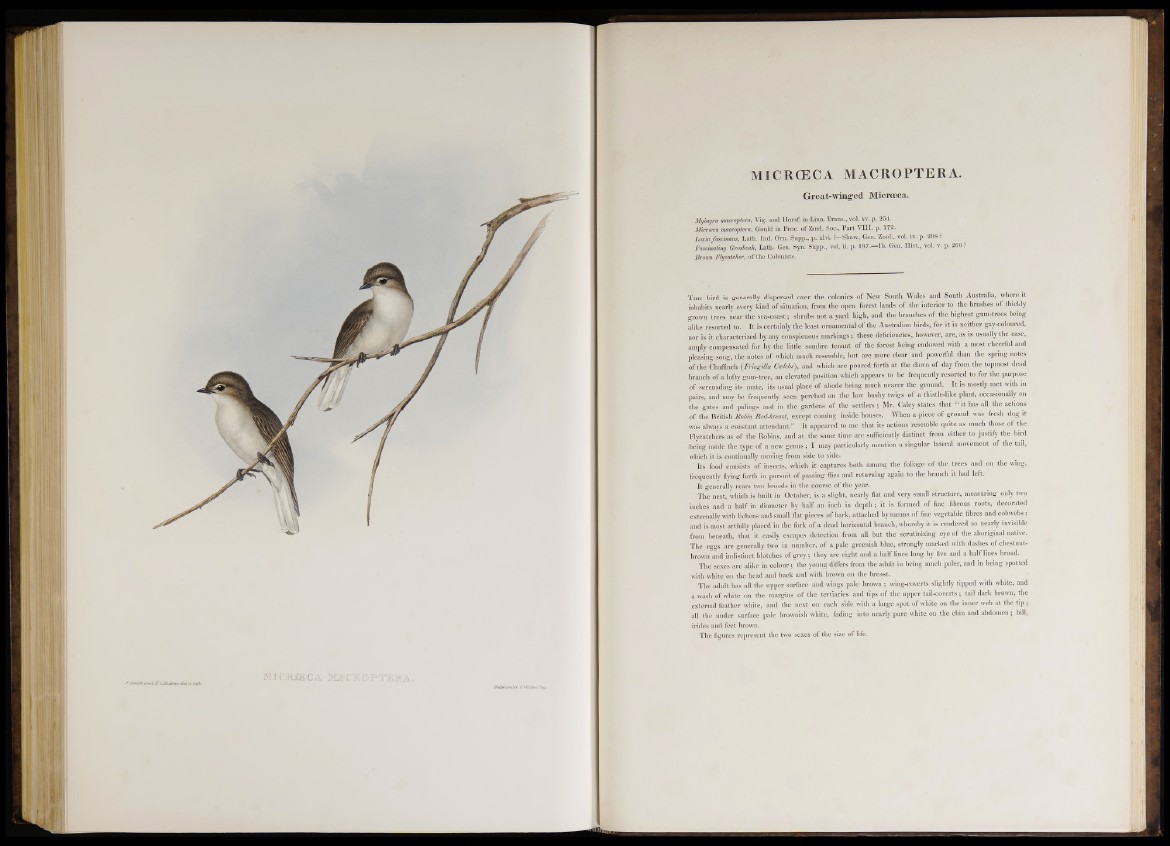
MICRCECA MACROPTERA.
Great-winged Micrceca.
Myiagra macroptera, Vig. and Horsf. in Linn. Trans., vol. xv. p. 254.
Micrceca macroptera, Gould in Proc. of Zool. Soc., Part V III. p. 172.
Loxia fascinans, Lath. Ind. Om. Supp., p. xlvi. ?—Shaw, Gen. Zool., vol. ix. p. 298 ?
Fascinating Grosbeak, Lath. Gen. Syn. Supp., vol. ii. p. 197.—Ib. Gen. Hist., vol. v. p. 266 ?
Brown Flycatcher, of the Colonists.
T h i s bird is generally dispersed over the colonies of New South Wales and South Australia, where it
inhabits nearly every kind of situation, from the open forest lands o f the interior to the brushes of thickly
grown trees near the sea-coast; shrubs not a yard high, and the branches o f the highest gum-trees being
alike resorted to. It is certainly the least ornamental of the Australian birds, for it is neither gay-coloured,
nor is it characterized by any conspicuous markings; these deficiencies, however, are, as is usually the case,
amply compensated for by the little sombre tenant of the forest being endowed with a most cheerful and
pleasing song, the notes o f which much resemble, but are more clear and powerful than the spring notes
of the Chaffinch (Fringilla Coelebs'), and which are poured forth at the dawn o f day from the topmost dead
branch of a lofty gum-tree, an elevated position which appears to be frequently resorted to for the purpose
of serenading its mate, its usual place o f abode being much nearer the ground. It is mostly met with in
pairs, and may be frequently seen perched on the low bushy twigs o f a thistle-like plant, occasionally on
the gates and palings and in the gardens o f the settlers; Mr. Caley states that “ it has all the actions
of the British Robin Red-breast, except coming inside houses. When a piece of ground was fresh dug it
was always a constant attendant.” It appeared to me that its actions resemble quite as much those of the
Flycatchers as o f the Robins, and at the same time are sufficiently distinct from either to justify the bird
being made the type o f a new genus; I may particularly mention a singular lateral movement of the tail,
which it is continually moving from side to side.
Its food consists o f insects, which it captures both among the foliage of the trees and on the wing,
frequently flying forth in pursuit of passing flies and returning again to the branch it had left.
It generally rears two broods in the course of the year.
The nest, which is built in October, is a slight, nearly flat and very small structure, measuring only two
inches and a half in diameter by half an inch in depth; it is formed of fine fibrous roots, decorated
externally with lichens and small flat pieces o f bark, attached by means of fine vegetable fibres and cobwebs;
and is most artfully placed in the fork of a dead horizontal branch, whereby it is rendered so nearly invisible
from beneath, that it easily escapes detection from all but the scrutinizing eye of the aboriginal native.
The eggs are generally two in number, o f a pale greenish blue, strongly marked with dashes of chestnut-
brown and indistinct blotches of grey; they are eight and a half lines long by five and a half lines broad.
The sexes are alike in colour; the young differs from the adult in being much paler, and in being spotted
with white on the head and back and with brown on the breast.
The adult has all the upper surface and wings pale brown ; wing-coverts slightly tipped with white, and
a wash o f white on the margins of the tertiaries and tips of the upper tail-coverts ; tail dark brown, the
external feather white, and the next on each side with a large spot of white on the inner web at the t ip ;
all the under surface pale brownish white, fading into nearly pure white on the chin and abdomen; bill,
irides and feet brown.
The figures represent the two sexes of the size of life.